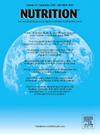控制营养状况评分和老年营养风险指数作为住院老年人死亡率和住院风险的预测因子
IF 3.2
3区 医学
Q2 NUTRITION & DIETETICS
引用次数: 0
摘要
背景:控制营养状况(CONUT)评分和全球营养风险指数(GNRI)是基于广泛可用的生化参数评估营养不良风险的筛选工具。本研究的主要目的是探讨CONUT和GNRI评分对住院老年患者36个月死亡率和住院风险的预测价值。方法:从意大利肌肉减少-营养治疗组织(GLISTEN)开展的意大利12个急性监护病房的多中心研究中检索382例患者(女性196例,平均年龄80.9±6.8岁)的资料。肌肉减少症被定义为低握力和低骨骼质量指数(EWGSOP2标准)。CONUT评分是根据血清白蛋白、总胆固醇和总淋巴细胞计数计算的,而GNRI是根据血清白蛋白和当前体重/理想体重比计算的。结果:在36个月的随访期间,382名参与者中有120人死亡(31.4%)。从生存分析的结果来看,在对潜在混杂因素进行调整后,conut衍生的中至高风险营养不良的参与者的生存期较短(HR = 2.67, 95%CI分别为1.34-5.33和HR = 3.98, 95%CI分别为1.77-8.97),无紧急住院的生存期较短(HR = 1.91;95% CI: 1.03-3.55, HR = 1.98;95% CI分别为1.14-3.42)。相反,只有指示营养不良高风险的GNRI是死亡率的独立预测因子1.96 (95% CI: 1.06-3.62),但不是住院率的独立预测因子。结论:CONUT评分似乎是预测长期死亡率和住院风险的有效工具。相反,GNRI与长期死亡率相关,但与再入院率无关。本文章由计算机程序翻译,如有差异,请以英文原文为准。
Controlling nutritional status score and geriatric nutritional risk index as a predictor of mortality and hospitalization risk in hospitalized older adults
Background
The COntrolling NUTritional Status (CONUT) score and the Global Nutrition Risk Index (GNRI) are screening tools for assessing the risk of malnutrition based on widely available biochemical parameters. The primary objective of this study was to investigate the predictive value of CONUT and GNRI score on 36 months mortality and hospitalization risk in hospitalized older patients.
Methods
Data of 382 patients (196 women, mean age 80.9±6.8 years) were retrieved from the multicenter Italian Study conducted by the Gruppo Lavoro Italiano Sarcopenia–Trattamento e Nutrizione (GLISTEN) in 12 Acute Care Wards. Sarcopenia was defined as presence of low handgrip strength plus low skeletal mass index (EWGSOP2 criteria). CONUT score was calculated based on serum albumin, total cholesterol and total lymphocyte count, whilst the GNRI was calculated using serum albumin and present body weight/ideal body weight ratio.
Results
During the 36-month follow-up, 120 out of 382 participants died (31.4%). From the results of the survival analysis, and after adjustment for potential confounders, participants with CONUT-derived moderate to high risk of malnutrition had shorter survival (HR = 2.67, 95%CI 1.34–5.33 and HR = 3.98, 95% CI: 1.77–8.97, respectively), as well as shorter survival free of urgent hospitalization (HR = 1.91; 95% CI: 1.03–3.55 and HR = 1.98; 95% CI: 1.14–3.42, respectively). Conversely, only GNRI indicative of high risk of malnutrition was an independent predictor of mortality 1.96 (95% CI: 1.06–3.62), but not of hospitalization.
Conclusion
The CONUT score seems a valid tool to predict long-term mortality and hospitalization risk. Conversely, the GNRI is associated with long-term mortality, but not with hospital readmissions.
求助全文
通过发布文献求助,成功后即可免费获取论文全文。
去求助
来源期刊

Nutrition
医学-营养学
CiteScore
7.80
自引率
2.30%
发文量
300
审稿时长
60 days
期刊介绍:
Nutrition has an open access mirror journal Nutrition: X, sharing the same aims and scope, editorial team, submission system and rigorous peer review.
Founded by Michael M. Meguid in the early 1980''s, Nutrition presents advances in nutrition research and science, informs its readers on new and advancing technologies and data in clinical nutrition practice, encourages the application of outcomes research and meta-analyses to problems in patient-related nutrition; and seeks to help clarify and set the research, policy and practice agenda for nutrition science to enhance human well-being in the years ahead.
 求助内容:
求助内容: 应助结果提醒方式:
应助结果提醒方式:


